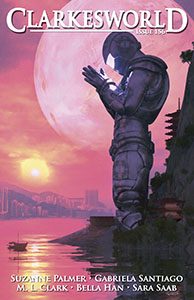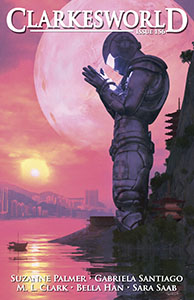Karen Burnham Reviews Short Fiction: Clarkesworld, Strange Horizons, BCS, Lightspeed, Tor.com, The Future Fire, and Cosmic Roots
 Clarkesworld 9/19
Clarkesworld 9/19
Strange Horizons 9/19
Beneath Ceaseless Skies 8/29/19
Lightspeed 10/19
Tor.com 9/11/19, 9/18/19
The Future Fire 8/19
Cosmic Roots and Eldritch Shores 8/19, 9/19
In September, Clarkesworld takes us all over the future and then back to the past. In the near future we have a trio of stories in various flavors of anomie and alienation. The most flat-out fun is “Dave’s Head” by Suzanne Palmer. The eponymous head belongs to an animatronic dinosaur that was scavenged from an educational amusement park by Cassie’s uncle Marty. Dave’s sad to be a lone dinosaur in a modern world, so asks Cassie to go on a road trip – a bit of a challenge in a time of slow societal collapse. But she’s up for it and loads up the car with Dave in the front and the mostly checked-out schizophrenic Marty in the back. They find a place with other dinosaurs, but something doesn’t feel right to Cassie…. I won’t ruin the reveal. Cassie’s a great tough heroine, and the story is enjoyably over the top. “Lapis” by Sara Saab is one of the more cyberpunk-feeling stories that I’ve read lately. Told in second person, Szanna is walking through a pestilence zone to get the highest-possible resolution maps for virtual space. She does most of her work in “realspace” (with a lot of augmented reality) but is vitally concerned with “bonespace” (what we’d call the real world) where she’s looking for a long lost friend. In this world many humans have achieved functional immortality, but the treatment doesn’t work for everyone and Szanna’s friend has become one of the pestilent ones. Scattered with references to older Gen X video games, this is a classic quest story, although without much in the way of resolution. Bella Han‘s characters are isolated not by plague but by social ennui in “Amorville“. Eva’s job writing marketing copy is likely to be usurped by AI soon, but for now she makes just enough that she can afford to immerse herself in interactive movie entertainment. She becomes obsessed with one particular actor, always choosing him to play the lead role in her films. All the different future entertainment options are clearly warping people’s relationships with each other – as we see when she goes on a disastrous date. Unfortunately, relationships with corporate products can’t be trusted, either.
Moving into the far future, “To Catch All Sorts of Flying Things” by M.L. Clark (the first of their stories I read this month) is a science fictional closed-planet murder mystery. The last egg of an extinct species has been attacked and blown up, and Greysl needs to get to the bottom of it. His investigation is complicated by the circumstances: this planet is shared by four different species and looked after by arachnid caretaker biocomputers. Greysl isn’t the smoothest talker – I appreciated his occasional verbal missteps with his human partners – and it gets even harder when he has to meaningfully communicate with the sentient fungus collective, among others. This story (unlike so many) comes to a satisfying conclusion.
At the end we go back into an alternate past. Imagine a world where the Indian peoples in South America had developed basic electricity and functioning automatons right before the Spanish landed on their shores. Gabriela Santiago‘s story “Malinche” unfolds through the eyes of a servant girl who is taken by the Spanish to be a translator between the different societies on the continent. As in our history, the Spanish take advantage of ongoing wars to gain power, then are the beneficiaries of the plague that wipes out huge swaths of the indigenous population. In the meantime, the girl is slowly gathering her own resources and making advancements and improvements to the electrical systems and automatons available. History goes in a very different direction with her involvement. This story uses a lot of words and phrases from the indigenous languages of the time and place, and doesn’t give a lot of allowance for the novice reader. For those who can work out the puzzles of both the history and the tech, this is a decidedly fascinating and grotesquely satisfying tale.
Along those same lines, Shiv Ramdas‘s story “And Now His Lordship is Laughing” in September’s Strange Horizons doesn’t pull any punches. Our viewpoint character is an older Bengali woman who makes lovely dolls out of jute. We meet her as one of her grandsons is hoping to learn her art. A representative of the British colonial government arrives and requests a doll for the governor’s wife. She declines in protest of some of the punishing policies already enacted in her state. Fast forward a little and almost everyone in her village, including her grandson, has died of starvation, suicide, or violence as a result of British policies diverting resources for the WWII effort in Europe. The man arrives again demanding a doll. This time she pulls herself together to make one last doll with one last enchantment… needless to say this story is not going to end the way the colonial governor apparently hoped it would.
The pair of stories in Beneath Ceaseless Skies #285 also look at acts of rebellion; in the case of “A Song for the Leadwood Tree” by Aimee Ogden, it is directly against colonialists. Nehan is the war leader of the Watuk, who are threatened by the Buskraten, and it is spears against rifles. Her daughters have died and her tongue has been cut out, but still she leads them. Unusually, she has adopted a young boy to follow her. As the final battle shapes up, it is clear that one way or another everything is going to change: whether they win or lose, stasis isn’t an option. I really appreciated the direction of the ending. In “The Sweetest Fruit of Summer” by R.K. Duncan, Corra is given by her village to be wife to a nomadic king, a kind of peace offering for leaving them alone. It turns out that he doesn’t want her as a wife or sex partner but as an oracle, since women from her area are some of the only ones who can survive the drug that lets them see the future. Once she gets the hang of her visions, just like the translator in Santiago’s story discussed above, she begins to add and subtract certain bits of information to aim her “husband” in a particular direction. It’s another story of those expected to be marginalized instead grabbing agency and taking the stories in their own directions.
In the world of Eleanna Castroianni‘s “The Silent Flowers of the Magician’s Garden” everyone has a small plot of land that they are spiritually connected to. The plants there sing songs related to the person and what their role is, even after their death – all except the flowers in the old magician’s plot. A boy is working for the magician, even though traditional gender roles say he should be training for the war that has already killed his two brothers. He has some of the same skills as the magician and desperately wants to apprentice to him. We think we know where this is going until the magician grants the young man insight into just what those flowers are really doing, which changes everything about the situation. There are very few innocents in a society at war.
Lightspeed‘s SF offerings in October start out on the far, icy moon Enceladus in “Nesting Habits of Enceladan Jade Beetles” by Eli Brown. A biological researcher’s suit is pierced by one of the eponymous beetles that he’s studying (the beetle’s natural history and an entire icy ecosystem are nicely brought to life, especially in the interstitial notes) and in order to save him his suit amputates his left hand and starts drugging him with “Terra-hope” to keep him from going into shock. He’s in communication with the station manager as a rescue is mounted, but the drugs make him loopy and he starts pouring out his heart and soul – about the beauty of the landscape, his worries about his boyfriend and potential romantic rivals, his career anxiety about publications and postings… the story does a great job of balancing the life-and-death tension with the genuinely funny ramblings of the protagonist. “The Death of Fire Station 10” by Ray Nayler, told by the first building AI to be recognized as sentient, is more poignant. Our viewpoint AI befriended the barely aware fire station of the title early in the story, and we learn about different kinds of building AIs as architecture and urban planning advance into the future. We also get the AI’s feelings about being removed from its home (even being declared sentient couldn’t prevent its original building from being demolished for more advanced ones) and how it adjusts to its lot in life. It’s a lovely story about how tech evolves and the feelings evoked when new generations replace older ones.
In September, Tor.com gives us “The Hundredth House Had No Walls” by Laurie Penny, a tale of a king who has grown tired of all the marvelous things he can bring into existence on his own. He wanders into New York City and meets an amazing cabaret singer, falling madly in love with her. Very quickly it turns out that she doesn’t fit neatly into the stories he tries to write around her, and the story turns sharply and entertainingly to metacommentary. On a more science fictional note, “The Vetting” by Michael Cassutt gives us a lawyer fighting cancer and also doing pro bono work with refugees at the Los Angeles International Airport. His client is not typical, a scientist of sorts trying to travel for a conference, but one focused on post-death experiences and the possibility that the soul can be shown to persist outside the body, depending on how the person dies. The lawyer is trying to sort through the legal details and gets quite discouraged about the man’s chances of proceeding into the country when the airport is attacked by terrorists. Obviously, in a short story that’s not a coincidence, and the lawyer quickly has to shift gears and determine just how seriously he takes the man’s theory about post-death.
The Future Fire released its 50th issue in August, a proud milestone! In celebration, the issue is all novelettes (plus poetry), and there’s a lot to chew on here. You’ll notice that almost every story centers on characters that are usually described as marginalized, and that fits neatly with its mission to showcase “Social-political and Progressive Speculative Fiction.” The lead story is “The Furious Chisel” by D.H. Kelly, where a disabled and confined girl takes joy in hacking her helper robots. One of them appears to achieve sentience, and she has to decide what to do about that. This story balances ethical questions with pragmatism, plus some sharp commentary on social attitudes towards the disabled. “And You Will Know Us By Our Monsters” by M.L. Clark (who is having a productive season) features a trans girl making her way via the sex trade in Colombia. When she’s recruited for a government outreach program to vulnerable women out in the FARC-area countryside, it turns out the government has ulterior motives. There’s a monster that she saw on the worst day of her life, and rumors about it have piqued broader interest. Going out and meeting other trans and cis women, she realizes that there are many other stories that are quite different than her own, and different ways to relate to the monsters. This story would have been interesting even without the speculative element (which sometimes seemed oddly incidental to the overall narrative flow).
On a more formally experimental note, “Goodbye, Snow Child” by Jo M. Thomas is told in repeating sections that at first change only very slightly from instance to instance. In each, a woman wakes up and can’t move or see. She engages in dialogue with two individuals, and is offered water. Each time she doesn’t remember anything about how she got there, although she starts to build up a sense, slowly, of what’s going on and what her powers might be in the situation. Not many venues would publish a story that re-uses so much of its word count and honestly takes so long to build up momentum, but I’d say the payoff is worth it. “Fairest of All” by Ada Hoffman features Siofran and Mahon – human children cast off (violently) by their families because of their autistic tendencies, who are independently “rescued” by fairies and brought to separate fae realms, where they’re basically enslaved by their rescuers. Siofran finally befriends Brogan, a gender non-binary otter who also has neuro-atypical tendencies, and they’re able to escape her confinement. Fate brings Mahon into their orbit, and he reacts very differently to what he learns from Brogan. Having a story with so many characters that might sometimes all get lumped under one label (“autistic”) really lets the author showcase a broad range of characterizations – there’s no monolithic stereotype here – and gives them agency to take their destinies into their own hands.
I’d like to take a moment to commend the poetry in this issue to your attention: “Walking on Knives” by Jeana Jorgensen takes the Little Mermaid story as its base but instead of a prince the young woman bargains with a sea witch for a full professorship. She trades knowledge to the witch and takes many young girls under her wing, teaching them more about life and surviv ing trauma than can be found in textbooks. It sounds dark, but manages to be funny as well as sharp. There’s also an interesting take on the traditional princess-and-the-pea fairy tale in “Not a Princess, But (Yes) There Was a Pea” by Rebecca Buchanan.
If those poems make darn good stories, I’d like to point out that Marie Brennan‘s “This is How” in Strange Horizons in September could make a very fine poem if the author wanted to nudge it in that direction. It describes a creature called a “valravn,” which is born when a raven happens to eat the body of a child who died alone, and then what happens when the valravn encounters the soul of a good man. It’s a short piece, very intense, with a lovely rhythm to the language.
In August, Cosmic Roots and Eldritch Shores gives us “Entanglement” by Christopher Blake. Our viewpoint character is a military quantum AI talking with the last survivor of an outpost being overrun by the enemy. The survivor uses the access codes from his superior to commandeer the AI, entangling them together, and projecting a tactile hologram to his wife’s home where he can see his newborn child for the first and last time. A bittersweet story, obviously, and the choice of narrator brings an interesting perspective to the occasion. The September story is a recently translated posthumous work by Naoko Awa, a Japanese children’s writer. “Ladder to the Moon“, translated by Toshiya Kamei, tells of Keiko and her rabbit Mimi. Rabbits are naturally drawn to the full moon, so when Keiko wakes up and Mimi is missing she knows just where she has to go. She meets a rabbit hunter and his lovely daughters, and some very helpful flowers. There are several artworks accompanying the pieces, ranging from adorable to quite lovely.
Recommended Stories
“Nesting Habits of Enceladan Jade Beetles”, Eli Brown (Lightspeed 10/19)
“To Catch All Sorts of Flying Things”, M.L. Clark (Clarkesworld 9/19)
“Fairest of All”, Ada Hoffman (The Future Fire #50)
“A Song for the Leadwood Tree”, Aimee Ogden (Beneath Ceaseless Skies 8/29/19)
“And Now His Lordship is Laughing”, Shiv Ramdas (Strange Horizons 9/9/19)
“Malinche”, Gabriela Santiago (Clarkesworld 9/19)
Karen Burnham is an electromagnetics engineer by way of vocation, and a book reviewer/critic by way of avocation. She has worked on NASA projects including the Dream Chaser spacecraft and currently works in the automotive industry in Michigan. She has reviewed for venues such as Locus Magazine, NYRSF, Strange Horizons, SFSignal.com, and Cascadia Subduction Zone. She has produced podcasts for Locusmag.com and SFSignal.com, especially SF Crossing the Gulf with Karen Lord. Her book on Greg Egan came out from University of Illinois Press in 2014, and she has twice been nominated in the Best Non Fiction category of the British SF Awards.
This review and more like it in the November 2019 issue of Locus.
 While you are here, please take a moment to support Locus with a one-time or recurring donation. We rely on reader donations to keep the magazine and site going, and would like to keep the site paywall free, but WE NEED YOUR FINANCIAL SUPPORT to continue quality coverage of the science fiction and fantasy field.
While you are here, please take a moment to support Locus with a one-time or recurring donation. We rely on reader donations to keep the magazine and site going, and would like to keep the site paywall free, but WE NEED YOUR FINANCIAL SUPPORT to continue quality coverage of the science fiction and fantasy field.







